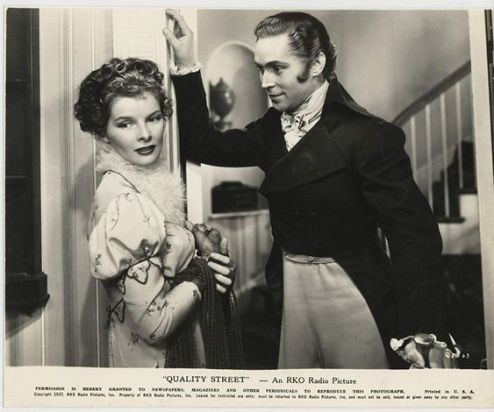
I’ve come to realize that I hadn’t participated in a blogathon since July (The Joan Bennett Blogathon)! I hope none of you take it personal, but with the beginning of my master in Stockholm, I didn’t want to commit myself to such things since I was afraid I might have to cancel. Anyway, Crystal (In the Good Old Days of Classic Hollywood) and Michaela (Love Letters to Old Hollywood)’s 2nd Spencer Tracy and Katharine Hepburn Blogathon was something I didn’t want to skip as I love writing about films starring one or both of them. As a matter of fact, I firmly believe that Katharine Hepburn is one of the most fascinating actresses to write about. The last time I reviewed one of her films was also a long time ago. So, it’s time to get back to Hepburn business!

Ps: It feels weird not writing about a Carry On!
Katharine Hepburn and Spencer Tracy both appeared in an incalculable number of memorable films. Kate began her on-screen acting career in 1932 in George Cukor’s A Bill of Divorcement, while Spence kicked things off in 1930 when he played a taxi driver in the short film Taxi Talks (Roy Mack). The two acting legends met and fell in love with each other while filming Woman of the Year (George Stevens, 1942). The rest is history.

Today, however, I’m going to focus on a film from Hepburn’s earlier career, Quality Street (1937), which was also directed by George Stevens. Her fictional love interest, this time, wasn’t embodied by Spencer Tracy but by the most dashing Franchot Tone.
Quality Street is hardly remembered as one of Hepburn’s best films or not remembered at all. Die-hard Hepburn’s fans probably have seen it but let say that it’s not the first title that comes to our minds when mentioning the actress’s name. However, Quality Street remains intriguing in many aspects — one being that Katharine Hepburn and Joan Fontaine once shared the screen, even if it was only for a few minutes. And, let’s admit it, it’s a pretty good film! Although I hadn’t heard much about it, the main reason why I decided to watch it is that I wanted to see more Estelle Winwood’s films. I saw this one listed and remembered the presence of other significant actors. So, there you have it. Winwood plays a supporting role, and she’s a real blast!
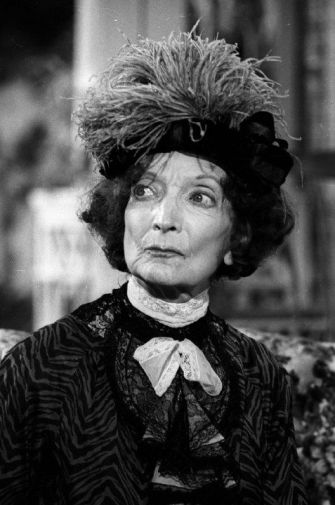
The 1937’s film takes place in England and begins in 1805. Phoebe Throssel (Katharine Hepburn) leaves on Quality Street with her elder sister, Susan (Fay Bainter). Pheobe, then 20 years old, has a man in view and hopes for him to propose to her. He is the handsome Dr Valentine Brown (Franchot Tone). As he visits the Throssel on a lovely day, he has important news to share with Pheobe. This one is convinced that he will propose to her. The reality is far different! Brown has enlisted in the army and is going to fight in the Napoleonic Wars.
Ten years later, the war is over, and the Throssels have been running a school for young children over the decade. Dr Valentine Brown is back home. As he pays a visit to the two sisters, he seems devastated by how Pheobe’s look has deteriorated. Yet, it’s far from being so. It’s only these old maid clothes that tarnish Pheobe’s appearance. She proves it by putting on a beautiful white gown and finds back her freshness and youth. When Brown, who comes back unexpectedly, sees her on her new day, he doesn’t recognize her. Their cook, Patty (Cora Witherspoon), identifies her as Livy, Pheobe’s niece. Pheobe decides to play the game, at her sister’s great exasperation and finds herself going to the ball with the handsome Brown. She’ll attract the eyes of many. But how far will this go?
Quality Street is a film that invokes many feelings such as love, humour, sadness, etc., all shared in their respective light. Furthermore, if we could draw a message from this story, it would be that things often don’t seem to be as they are. Indeed, this is mostly embodied in the conception of the “old maid” and the negativity that comes with it. Pheobe is only 30 after the war but, at the time, if you hadn’t married by 25, you were considered to be an old maid and would probably stay home alone, knitting forever. Of course, Katharine Hepburn challenges this sexist vision of the woman of the past by proving that people often get the wrong impression of someone and that there are things more important than age. Moreover, there is a side story between Throssel’s cook, Patty (Cora Witherspoon) and the Recruiting Sergeant played by the always hilarious Eric Blore. Patty is older, not necessarily pretty (at least, not in the conventions) but she doesn’t care. To her, the hope of finding someone is still a possibility, and she optimistically sees that side of life. We eventually have the idea that she and the Recruiting Sergeant might be made for each other.
Susan and Pheobe’s bunch of old maid-friends led by Mary Willoughby (Estelle Winwood) represent this very narrow-minded vision of the society in which a woman if she’s past 25, will most likely never get married. To them, everything must be done properly, and a woman must stay where she is until a man presents an interest in her. The woman cannot go after the man; it is the man that has to go after her. And if this doesn’t happen, well, too bad. Luckily, Pheobe has more than one trick in her bag to escape from Mary’s constant watching. When they meet Livy, they suspect her to be the same person as Pheobe. Of course, they aren’t wrong! So, they follow Livy (or Pheobe) to the ball to investigate. Luckily, Pheobe doesn’t have to make many efforts to convince them that Pheobe and Livy are both present at the ball. That gives place to a hilarious scene where Katharine Hepburn identifies herself as Pheobe to Mary & Co. As these see someone from afar wearing the hat Livy (Pheobe) was wearing when they first met her, they conclude that this person is Livy. However, it’s Patty who has come to the ball to warn Susan and Pheobe that their “friends” were on their way to see them. She only put Livy’s hat on to hide.
A few shots from the famous scene
A short outline in Motion Picture Herald highlights the importance of women’s roles in this film by saying that it is “A very pleasing production, especially from the women’s standpoint”. (1) The film is very much about how women perceive other women and how they perceive themselves and their roles within society.
Even though Quality Street isn’t Katharine Hepburn’s best-known film, I believe it presents one of her most skilled and subtle acting games. It’s not without reason that the actress was nicknamed The Great Kate. If you compare her performance as Pheobe Throssel to the one in The Philadelphia Story, you quickly realize her ability to adapt herself to all types of characters and show an undeniable versatility. We often think of Katharine Hepburn as this tall woman, very sure of herself, with her signature voice. In Quality Street, Katharine Hepburn is softer, and her beautiful acting challenges our emotions. Just look at the way she moulds herself into Livy and then Pheobe with impressive ease. No wonder Brown is fooled! We love this scene in the garden at the beginning of the film where Katharine Hepburn plays a shy and modest Pheobe, a Pheobe who’s in love and who expects her life to change as she’s waiting for the doctor to tell her the news. It will change indeed but not in the way she expects it. Katharine Hepburn plays perfectly the hidden deception. With only a few facial tricks, we understand immediately that her heart is broken but that she tries not to show it to the doctor.
Picture Play magazine published a pertinent article that compares Hepburn’s acting to Fay Bainter’s or, more precisely, how they deliver themselves to the screen. Briefly, they conclude that Bainter steals the show despite Hepburn being the “big” star. The newspaper writes:
Katharine Hepburn always surprises. Sometimes it’s by the beauty, truth, and originality of her acting- or the awkwardness and inadequacy of it. […] This time, she surprises even more. Though nominally the heroin of the story, she permits the character’s problems to be felt more poignantly by her elder sister. Fay Bainter, of the stage, proves her greater skills by communicating to the spectator more than Miss Hepburn. She feels from within while the star is concerned with surface manifestations. In short, Miss Bainter “steals” the picture. (2)
While I do see what they mean, I think the idea of Fay Bainter stealing the picture shows a misunderstanding of both actresses’ roles. Bainter is indeed the one really bearing the suffering as she never got the chance to marry because her beau didn’t find her pretty enough. She represents the “failure” of this old-fashioned matrimonial concept. So, her acting and the conception of her character is more tragic and maybe more poignant than the one of Hepburn for that matter. On her side, Katharine Hepburn expresses suffering when Dr Brown fails to see the love she has for him. However, her acting has to be calculated in a different way than Bainter’s as she embodies a certain hope for women’s condition and, eventually decides to do more than she has done before to reach her means. In other words, Fay Bainter and Katharine Hepburn complete each other to perfection. Both actresses had tender chemistry and would share the screen later in Woman of the Year where the magic of their duo would have not faded.

Franchot Tone is a great actor but mostly presents himself as the handsome man in the case of Quality Street. His charisma is undeniable, and it might be the film that made me notice him for good. He uses his charm to perfection, mostly in a way for us to understand better Pheobe’s feelings towards him. The film is more about 19th-century women than 19th-century men, but it still concerns both of them. Tone, as Dr Brown, first seems to have more of a passive role and be the subject that provokes the reactions. He is here, enjoys the presence of the lovely Livy and, for a moment, it looks as simple as this. However, his character remains important in the way that he sort of challenges Pheobe’s life, both positively and negatively. That is particularly obvious at the end when the real thoughts of the doctor are finally revealed. I will let you watch the film to discover how!
If you want to look at the more comical and lighter side of this film, you need to pay attention to the presence of Eric Blore, Estelle Windwood, and Cora Witherspoon, whom, in their respective way, give this film a breath of fresh air and make it highly agreeable to watch. One thing that will never fail to make me laugh is Eric Blore’s worried face. It’s something I can perfectly picture in my mind as I am writing these lines as it was so proper to him. And how can we forget his signature and exaggerated wink to an exasperated Estelle Winwood (who, by the way, is a master at eye-rolling)? The two present a funny contrast as Winwood is the respectable lady who would never dare to make a wrong move, while Blore is this daring jester. I mean, this guy only has to “exist” to be funny. What I particularly liked about Estelle Winwood’s character is how she is serious but, in a way, that makes her hilarious. Just think of that scene where she “smells” a man in the house. Her exaggeratedly neutral tone of voice accompanies that perfectly. On her side, Cora Witherspoon becomes an appreciate comic allies for Susan and Pheobe. Her moment of glory is the one at the ball that I was mentioning earlier. Just like Winwood, she also has some memorable scenes with Blore, and the two make a terrific pair.
One thing that makes Quality Street particularly noticeable also is the presence of a young and uncredited Joan Fontaine. We see her twice in the film during very brief moments, but it’s impossible not to notice her. First of all, she has that very distinguished low voice and the charming laugh that will follow her for the rest of her career. We observe it in a scene where her character, Charlotte Parratt, is taking a walk with Dr Brown. We also see her sharing a scene with Katharine Hepburn when both characters are playing cricket with a few handsome soldiers. Her irritated reaction, when Katharine Hepburn throws the ball very far, which forces the man she was talking with to go away, is just perfectly calculated. Camera work helped a lot by giving her a brief but noticeable and dynamic close up. As a matter of fact, Katharine Hepburn was one of those actresses who believed in Joan’s talent as it is indicated in an article in Modern Screen: ” [W]hile playing a small part in ‘Quality Street’, Joan caught the eye of Katharine Hepburn, and Hepburn went bat for her. ‘You ought to give that girl a lead’, she told RKO big bugs”. (3) And that’s what happened when Joan got the leading part in her next film, The Man Who Found Himself (Lew Landers, 1937). Katharine certainly had an eye for things of quality because Joan’s presence in the film is very small… but full of potential!
Quality Street was based on a Broadway play by J.M Barrie (the creator of Peter Pan) and originally starred Maude Adams. It premiered in 1901 at Knickerbocker Theatre where it ran for 64 performances. (4) That wasn’t the first on-screen adaptation of Barrie’s work since a silent film had been made before in 1927, starring Marion Davies and Conrad Nagel. Despite the critics’ praise for Davies’s performance, the film was one of the actress’s less popular picture at the Box office. (5) However, despite that, it still made a profit for MGM studio. (6) Screenwriters Allan Scott and Mortimer Offner adapted the play for the 1937 version. What I love about some of the lines is the choice of words which is pretty and precise. For example, I love when Pheobe says “I met a certain individual” instead of “I met someone”. Said this way, it sounds as if this person had something truly special. There’s also this graceful scene when Dr Brown compares Pheobe to a garden: “To me you’ll always be like this quiet, old-fashioned garden full of the flowers I love best because I’ve known them longest. The daisy that stands for innocence, the hyacinth for constancy, the modest violet, and the rose”. On the funny side, the way that Mary Willoughby describes how the Recruiting Sergeant winked at her reflects pretty well the nature of her character:
Mary Willoughby: [Goes to the window and looks out] It’s that impertinent recruiting sergeant. I passed him on the street yesterday. He closed one of his eyes at me, then quickly opened it again.
[She demonstrates to the other ladies in the room]
Mary Willoughby: I knew what he meant.
[She looks out again and sees the recruiting officer winking at her. She quickly closes the window curtain] (7)
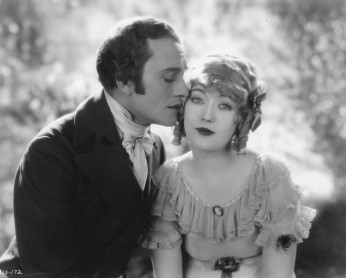
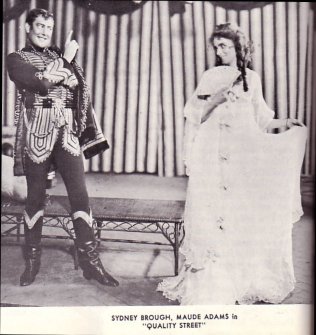

We also have to pay attention to Walter Plunkett’s beautiful costumes that make this black and white film highly colourful!
Quality Street was a box office flop but still got some recognition at the 1938’s Academy Award when it was nominated for Best Score. The music composed by Roy Webb isn’t necessarily the most memorable you’ll ever hear in a film. However, it’s a composition that accompanies well the atmosphere of the film and its simplicity. It’s, without a doubt, a pleasant melody.
Even if Quality Street is a “forgotten film”, I hope some of you will agree with me that it’s underrated. I didn’t have to force myself to like it or convince myself that I liked it even if it wasn’t the case. No, I liked it as it was and always spent an agreeable moment whenever I’m watching it. And there’s so much to say about it, even if it doesn’t seem so at first sight!
Many thanks to Crystal and Michaela for hosting this awesome blogathon!
You can check the rest of the reviews here.
See you!
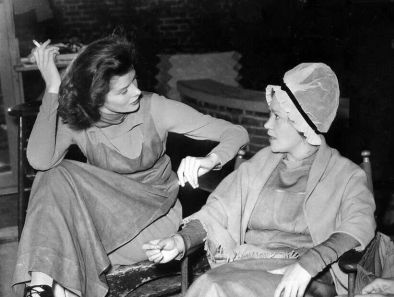
Notes:
(1) Quigley Publishing Co. “Quality Street.” Motion Picture Herald, December 4, 1937, 66, Media History Digital Library.
(2) Lusk, Norbert. “Reviews: Quality Street.” Picture Play, 1937, 59, Media History Digital Library.
(3) Baskette, Kirtley, “Handle with Care.” Modern Screen, August, 1940, 71, Media History Digital Library.
(4) “Quality Street (1937): Trivia.” IMDB, n.d., https://www.imdb.com/title/tt0029454/trivia?ref_=tt_trv_trv. Accessed Oct 12, 2019.
(5) “Quality Street (1927): Trivia.” IMDB, n.d., https://www.imdb.com/title/tt0018297/trivia?ref_=tt_trv_trv. Accessed Oct 12, 2019.
(6) Ibid.
(7) “Quality Street (1937): Quotes.” IMDB, n.d., https://www.imdb.com/title/tt0029454/quotes/?tab=qt&ref_=tt_trv_qu. Accessed Oct 12, 2019



































Great review. Haven’t seen it for an age but remember enjoying it,
LikeLiked by 1 person
Thank you! I’m glad you did. It definitely deserves more attention than it gets
LikeLike
You have done an excellent job recounting the joys of Quality Street, a particular favourite of mine. I know what you mean by it not being Kate’s most well-known or received film for some reason. Years ago on the IMDb chat board I listed it as a favourite and some fellow flat out told me I was “wrong.” Can you believe it?
I don’t mean to be pushy, but seeing that we are both Quality Street fans I must share my piece on the movie which you can peruse at your leisure if and when you like.
https://www.caftanwoman.com/2017/02/caftan-womans-choice-one-for-march-on.html
LikeLiked by 2 people
Wow I hate when people wants to choose what you like or not! That’s the thing that is « wrong ». Of course I would love to read your article! Thanks so much for reading mine and for your kind comment 🙂
LikeLiked by 1 person
[…] The Wonderful World Of Cinema – Quality Street ( 1937 ) […]
LikeLike
Fabulous review, Virginie! I saw this film a few years ago and I remember liking it well enough, but I forgot what an incredible cast it had until your post reminded me. I definitely need to watch it again! I loved what you said about Hepburn and her performance, too.
Thanks so much for contributing to our blogathon!
LikeLiked by 1 person
Thanks for your kind words Michaela! Yes, the casting is pretty amazing!
LikeLiked by 1 person
[…] of Cinema was nominated for a CMBA Award in the Best Comedy/Musical category for my article on Quality Street (George Stevens, 1937)! Aside from that, I now have 436 followers, and I’ve almost published […]
LikeLike